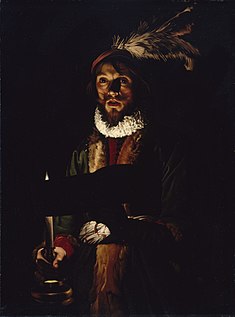Adam de Coster
It is known he was originally from Mechelen where he was born in the year 1585 or 1586 as the son of Jan de Coster and Clara van der Borcht.
Some of the recently rediscovered works of de Coster were part of Italian collections, which also points to a possible residence in Italy.
His oeuvre has been reconstituted mainly on the basis of an engraving made by Lucas Vorsterman the Elder (1595–1675) after the lost painting Backgammon or Tric-trac players by candle light.
[7] The English art historian Benedict Nicolson played an important role in the rediscovery of the artist and the re-attribution of works to de Coster.
[10] Adam de Coster's oeuvre is mainly composed of genre paintings with half-length figures and dramatic light effects.
[10] His subjects are those that one typically finds with Caravaggio and his followers: card sharps, fortune tellers, prostitutes, musical performances, the denial of St Peter etc.
De Coster returned to certain themes regularly and various versions of the Denial of St Peter and the Card Players exist.
He also painted Two Sculptors at Night in Rome (Statens Museum for Kunst), which is possibly a double portrait of Francois Duquesnoy and Georg Petel.
De Coster shows his mastery in the sensuous rendering of the fabric of the female singer's dress and the way it catches the light.




